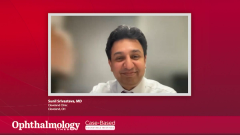
Managing Chronic Postoperative Uveitis: Patient Case 2
Sunil Srivastava, MD, presents a case of postoperative macular edema, which required him to move beyond short-acting steroids to control the inflammation.
This video synopsis captures a discussion featuring Sunil Srivastava, MD, a specialist in uveitis and retina at the Cleveland Clinic. Dr. Srivastava presented a challenging case involving a 68-year-old female who underwent complex cataract surgery resulting in a three-piece sulcus eye well placement. The patient faced complications, including vitrectomy, lensectomy, and subsequent dislocation of the three-piece eye well, leading to a Gore-Tex sutured eye well.
Postoperatively, the patient developed inflammation and cystoid macular edema (CME). The panel discussed the initial approach to postoperative CME, reaching a consensus on using topical therapy, with a split between difluprednate and prednisolone acetate. The patient responded well initially but required an intravitreal triamcinolone injection to control recurrent cystoid macular edema. Notably, due to the sutured eye well, the use of a dexamethasone implant was contraindicated to prevent migration issues into the anterior chamber.
The patient ultimately received an intravitreal fluocinolone acetonide implant, leading to sustained improvement over a three-year follow-up, maintaining normal intraocular pressure (IOP) and achieving a vision of 20/32. The case highlighted the challenges of managing cystoid macular edema post-complicated cataract surgery and the efficacy of long-term treatment with the fluocinolone implant.
In a second case discussed by Dr. Srivastava, a patient experienced a macular pucker in the right eye and epiretinal membrane after retinal detachment repair and uncomplicated cataract surgery. Despite post-surgery improvement, the patient developed recurrent macular edema, necessitating eight dexamethasone implants. The panel deliberated on defining macular edema and the threshold for intervention.
Eventually, the patient received two fluocinolone C9 implants, resulting in sustained improvement, emphasizing the importance of monitoring intraocular pressure and tailoring treatment plans to individual cases. This case illustrated the complexity of managing chronic macular edema and the potential role of long-term steroid implants in achieving positive outcomes.
Video synopsis is AI-generated and reviewed by Ophthalmology Times® editorial staff.
Newsletter
Don’t miss out—get Ophthalmology Times updates on the latest clinical advancements and expert interviews, straight to your inbox.






